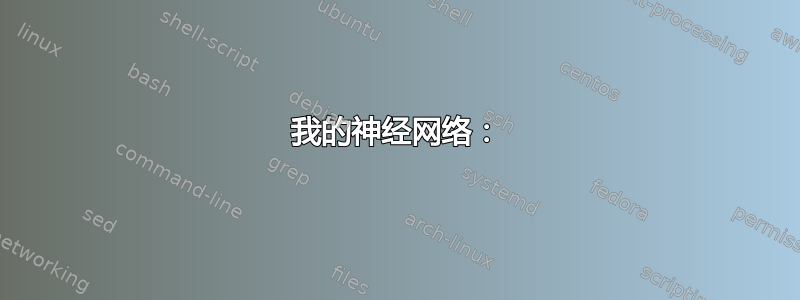
我正在尝试绘制如下所示的神经网络,但我想在一开始就画一个正方形,具体来说:
我的神经网络:
\documentclass[12pt, oneside, letterpaper]{book}
\usepackage{amsmath,amssymb,amsfonts,amsthm}
\usepackage{graphicx}
\usepackage{neuralnetwork}
\usepackage{xpatch}
\makeatletter
\xpatchcmd{\linklayers}{\nn@lastnode}{\lastnode}{}{}
\xpatchcmd{\linklayers}{\nn@thisnode}{\thisnode}{}{}
\begin{document}
\begin{figure}[h]
\centering
\label{fig:arquitectura_autoencoder}
\begin{neuralnetwork}[height=9.5,nodespacing=1cm,nodesize=20pt, layerspacing=3.6cm][h]
%comandos previos
\newcommand{\x}[2]{\ifthenelse{\equal{#2}{0}}{$b_0$}{\ifnum #2=8 $x_n$ \else $x_#2$ \fi}} %si es el índice cero, entonces le asignas b0, sino si es la neurona 8, lo cambias por el índice n
\newcommand{\ffirst}[2]{\ifthenelse{\equal{#2}{0}}{$b_1$}
{\ifnum #2=4 $a_{\frac{n}{2}}^{(2)}$ \else $a_{#2}^{(2)}$ \fi}}
\newcommand{\fsecond}[2]{\ifthenelse{\equal{#2}{0}}{$b_2$}
{\ifnum #2=3 $a_{\frac{n}{4}}^{(3)}$ \else $a_{#2}^{(3)}$ \fi}}
\newcommand{\fthird}[2]{\ifthenelse{\equal{#2}{0}}{$b_3$}
{\ifnum #2=4 $a_{\frac{n}{2}}^{(4)}$ \else$a_{#2}^{(4)}$ \fi}}
\newcommand{\xhat}[2]{\ifthenelse{\equal{#2}{0}}{$b_0$}{\ifnum #2=8 $\hat{x}_n$ \else $\hat{x}_#2$ \fi}}
%red neuronal
\inputlayer[count=8, bias=true,exclude={7},title=Input\\layer, text=\x]
\hiddenlayer[count=4, bias=true,exclude={3},title={$L_2$\\$f_{\cdot 2} = \tanh(x)$}, text=\ffirst]
\linklayers[not from={7},not to={3}] %para que no dibuje la flecha desde la neurona 7
\hiddenlayer[count=3, bias=true,exclude={2}, title={$L_3$\\$f_{\cdot 3} = ReLU(x) $}, text=\fsecond]
\linklayers[not from={3},not to={2}]
\hiddenlayer[count=4, bias=true,exclude={3}, title={$L_4$\\$f_{\cdot 4} = \tanh(x)$}, text=\fthird]
\linklayers[not from={2},not to={3}]
\outputlayer[count=8, exclude={7},title={Output layer\\$\hat{x}_i=a_{i}^{(5)}$}, text=\xhat]
\linklayers[not to={7},not from={3}]
% draw dots
\path (L0-6) -- node{$\vdots$} (L0-8);
\path (L1-2) -- node{$\vdots$} (L1-4);
\path (L2-1) -- node{$\vdots$} (L2-3);
\path (L3-2) -- node{$\vdots$} (L3-4);
\path (L4-6) -- node{$\vdots$} (L4-8);
\end{neuralnetwork}
\end{figure}
\end{document}
生成:
我想要的是类似的东西,但我想要在输入层和输出层之前放一个小方块,因为我想添加更多信息。我附上了一个我想要的类似图像。
我想要的是:
这可能做到吗?我认为这很难。
答案1
没有这个neuralnetwork包,绘制出你想要的截图之类的东西还是相当容易的。
\documentclass[12pt, oneside, letterpaper]{book}
\usepackage{tikz}
\usetikzlibrary{calc,positioning,shapes.geometric}
\begin{document}
\begin{figure}[h]
\centering
\begin{tikzpicture}[neuron/.style={ellipse,minimum width=1.2em,minimum
height=1.6em,draw,thick},
box/.style={draw,minimum height=3.4em+#1,text width=2em,align=center},
font=\sffamily\tiny,yscale=1.25,node distance=1cm,
every label/.append style={node font=\tiny},
Dotted/.style={% https://tex.stackexchange.com/a/52856/194703
dash pattern=on 0.1\pgflinewidth off #1\pgflinewidth,line cap=round,
shorten >=2mm,shorten <=2mm,line width=2pt},
Dotted/.default=4,thick]
\begin{scope}[local bounding box=neurons]
\path foreach \X in {1,...,4}
{(-2,{-\X-(\X==4)*1.5}) node[neuron](x\X){}
\ifnum\X=4
edge[Dotted,line width=2pt] (x3)
\fi
(2,{-\X-(\X==4)*1.5}) node[neuron](y\X){}
\ifnum\X=4
edge[Dotted] (y3)
\fi};
\path foreach \Y in {1,2,3}
{([yshift=2cm-\Y cm]neurons.center)
node[neuron,label=above:N\Y] (N\Y){}
foreach \X in {1,...,4} { edge (x\X) edge (y\X)}};
\end{scope}
\node[above=6mm of N1,align=center]{Hidden\\ Nodes};
\path let \p1=($(neurons.north)-(neurons.south)$) in
node[box=\y1,left=of neurons] (PCAC) {PCA Compression}
node[box=\y1+2cm,left=of PCAC] (Ori) {Original HIV Data}
node[box=\y1,right=of neurons] (PCAD) {PCA Deompression}
node[box=\y1+2cm,right=of PCAD] (Pre) {Predicted HIV Data};
\draw foreach \X in {1,...,4}
{ (x\X) -- node[near start,above]{x\X} (PCAC.east|-x\X)
(y\X) -- node[near start,above]{y\X} (PCAD.west|-y\X)};
\draw foreach \X [count=\Y] in {0.1,0.2,0.3,0.4,0.9}
{ ($(PCAC.north west)!\X!(PCAC.south west)$)
-- coordinate (w\Y) ($(Ori.north east)!\X!(Ori.south east)$)
($(PCAD.north east)!\X!(PCAD.south east)$)
-- coordinate (e\Y) ($(Pre.north west)!\X!(Pre.south west)$)}
(w4) edge[Dotted] (w5) (e4) edge[Dotted] (e5);
\end{tikzpicture}
\caption{A neuronal network.}
\label{fig:arquitectura_autoencoder}
\end{figure}
\end{document}





